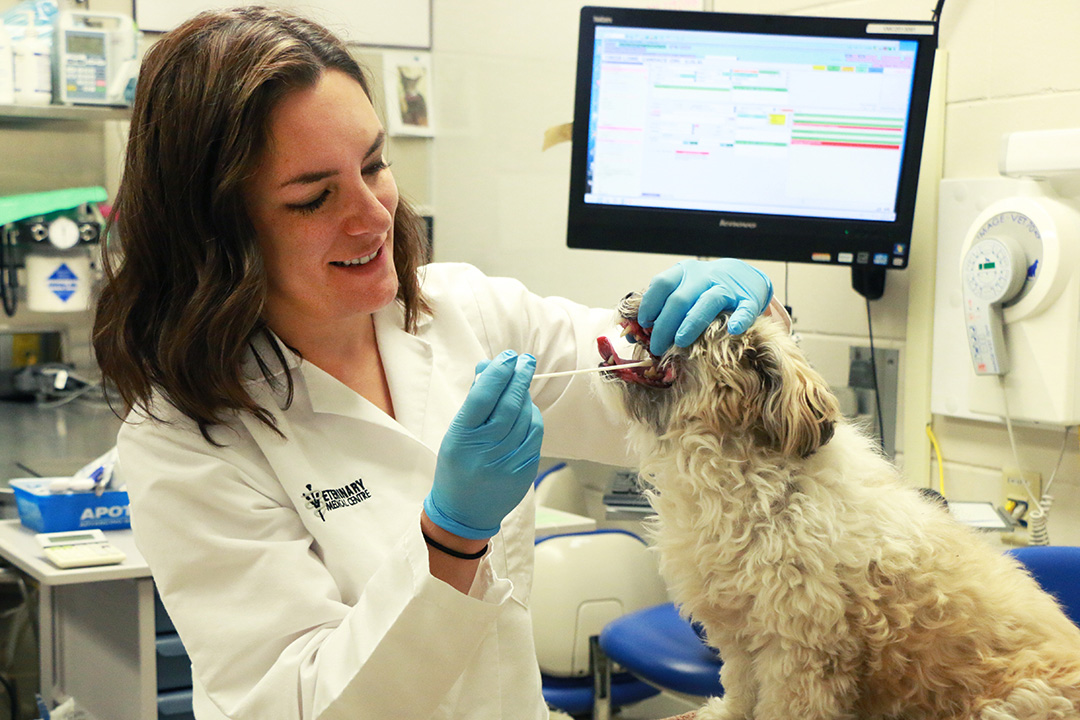
Dog saliva study helps dentistry students make connections across campus
As the College of Dentistry works to expand research capacity and output, its students are thinking outside the box about their own investigations and tapping into opportunities created by the university’s One Health Initiative. Designed to advance both research and education through the integration of disciplines, the initiative is opening doors across campus for dentistry students to learn and explore solutions at the human-animal-environment interface.
By Taryn RiemerSecond-year dentistry students Jessa Drury, Lisa Bachiu and Susanne Skulski were sitting in their endodontics class when they came up with the idea of how they could connect their schooling at the College of Dentistry with veterinary medicine.
“Our professor was showing us a video of a root canal he was doing on a ferret, and we had a light bulb go off,” said Drury. “So, when we were in our dentistry table clinics class and needed to find a research project, we thought it would be cool to work with a veterinary dentist.”
The three students—all pet lovers— decided to search on the USask Western College of Veterinary Medicine (WCVM) website to see if they could find someone who could help. Their search led to Dr. Candace Lowe, a board-certified veterinary dentist and an assistant professor in the WCVM’s Department of Small Animal Clinical Sciences.
“The students contacted me and asked what kind of project we could do,” said Lowe. “I was happy to help them out, and we tossed a few ideas back and forth until we decided on the raw meat study.”
For Lowe, it was the perfect opportunity to study a topic that she had wanted to investigate for some time: do dogs that eat raw meat diets have zoonotic bacteria in their mouths?
“We know from published studies that there are zoonotic bacteria that can be passed on to humans in raw diets as well as in the feces of the dogs that eat raw diets. However, no one has investigated whether zoonotic bacteria are in their mouths,” said Lowe.
Escherichia coli, Salmonella and Campylobacter spp. are the zoonotic bacteria species that cause the most concern. If these species are found in dogs’ mouths, there’s a potential for the bacteria to be transmitted to humans when the dogs lick their owners or even lick floors where young children crawl or play.
After spreading the word among Saskatoon’s dog community, Lowe and the three dentistry students had over 60 dogs enrolled in the study: 30 dogs that ate raw meat diets and 30 dogs that ate kibble-based diets. Owners had to bring their dogs to the WCVM’s Veterinary Medical Centre within an hour of the animals’ last meal so the research team could swab the dogs’ mouths.
WCVM students also pitched in to help the dentistry team collect the dogs’ saliva samples. “They were really helpful with actually doing the swabs … because we walked in and didn’t really know what to do. Do we ask it [the dog] to sit? Do we ask it to open wide?” said Drury, laughing.
Along with the regular saliva collections, the dentistry students frequently met with Lowe while she was working on patients— another intriguing part of the collaborative research project.
“One time, we came over for the meeting and she was sewing up a bilateral broken mandible [jaw], and we were like ‘wow,’” said Skulski.
“We offered to come back, but she just told us to come over and check it out,” added Bachiu.
In early May, the three dentistry students presented a research poster titled, “Identification of bacterial zoonotic pathogens in the oral environment of dogs fed a raw-food diet,” at the 2018 Life and Health Sciences Research Expo on the USask campus. They hope to eventually have their research published.
Although a large portion of the study is complete, the group still hopes to find more participants. “I’d love to have 50 dogs in each group (raw meat and kibble-based diets), so we’re still looking for volunteers,” said Lowe.

